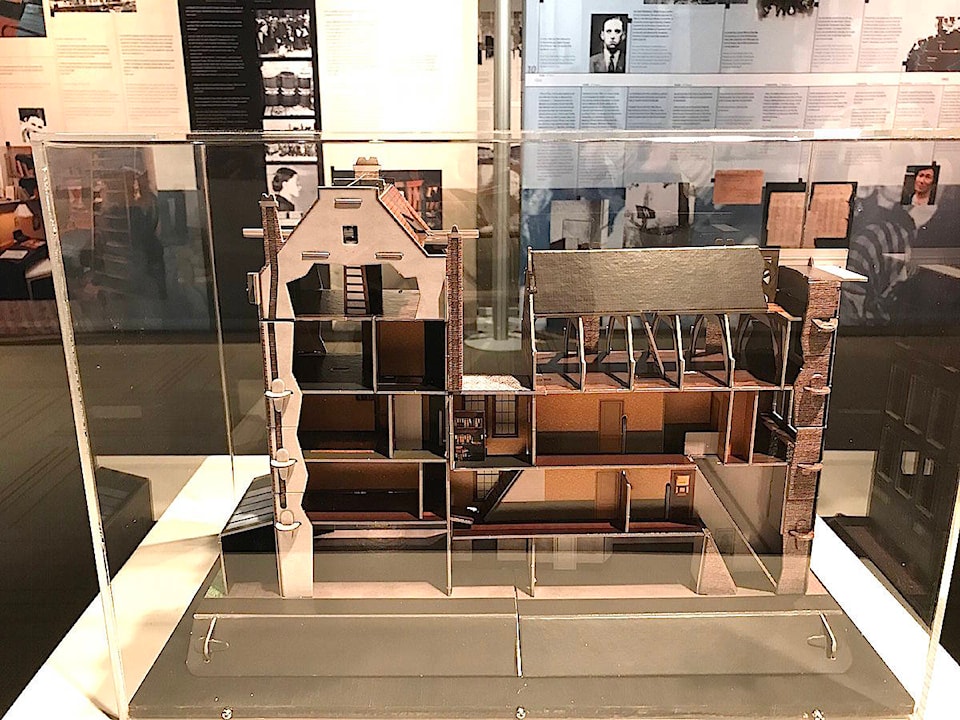Kids who read The Diary of Anne Frank either connect with the teenage author, or they find her too serious, too full of big thoughts and ideals, and in an unrelatable situation.
Kim Verrier, exhibits co-ordinator at the Red Deer Museum and Art Gallery, admits she fell within the latter group.
“I was the same age when I was reading the book as she was when she (started writing) it,” said Verrier — which was 13 years old.
“But she was a very different kid than me, very mature, and experiencing things I couldn’t imagine.”
It wasn’t until Verrier saw video footage of prisoners in Nazi concentration camps that she felt the full impact of Anne’s words — “and then it was so shocking to me, that something like this could have really happened…”
Through informational panels and artifacts, the new Anne Frank exhibit at the museum and art gallery provides plenty of context to the nightmarish environment that Jewish people were in before and during the Second World War.
To avoid concentration camps, the Franks and some of their friends were forced to hide above an Amsterdam warehouse for two years — until they were found out and hauled off to Auschwitz, Bergen-Belsen and other factories of death.
Of the eight people who were in hiding, only Anne’s father Otto, survived the war. He died at age 91 in 1980.
By sheer chance, Verrier came across two letters that Otto had written to the mother of a local woman, in response to letters she had sent him as a schoolgirl in 1967 and 1968.
The girl must have expressed her relief to live in a free country, as Otto replied, “But in looking around, you must realize that we still do not live in a peaceful world as there are still wars and discrimination and the persecution of innocent people” based on race and religion.
He encouraged the student to help make it a better world.
Verrier believes this sentiment also underscores the importance and continuing timeliness of Anne Frank’s story — since migrants, immigrants and minorities are again being vilified, deported and imprisoned.
Anne was an immigrant, as well as a Jew, she said, noting the Franks had moved from Germany to Holland to try to escape Nazism when Anne was a young child.
Seldom-seen family images of tea parties and days spent at the beach can be seen in this travelling exhibition from the Anne Frank House Museum in the Netherlands. Anne’s personal story is set against the wider Holocaust on panels that are divided between a family timeline and a framework of what was happening to Jews across Europe.
Political developments are recounted — from the rise of National Socialism, to the start of the war and the official persecution and eventual annihilation of millions of adults and children.
In a videotaped interview, Otto admitted that, like many parents, he never truly appreciated that his child was growing up.
Anne’s mature reasoning was a revelation to him as he read her diary, which Anne had rewritten in part, hoping for its eventual publication.
“I was surprised by her deep thoughts, her seriousness, and self-criticism,” said Otto. “She had never showed this kind of inner feeling…”
A reception for the exhibit will be held on Sunday, Jan. 26, from 2 to 4 p.m.
Grandchildren of Holocaust survivors will speak at the museum on Feb. 2 and March 1 at 1 p.m., and on March 22, Sandra Mortin Weizman will talk about the history of the Jewish community in Alberta.
lmichelin@reddeeradvocate.com
Like us on Facebook and follow us on Twitter
